链表相关OJ及方法总结
目录
第一类:改变链接关系
第二类:快慢指针
第一类:改变链接关系
1. 删除链表中等于给定值 val 的所有结点。

(1)原地删除
struct ListNode* removeElements(struct ListNode* head, int val){if(head==NULL){return head;}struct ListNode* cur=head,* pre=NULL,* ret;while(cur){//需要删除curif(cur->val==val){ //cur是首节点,需要改变头结点if(pre==NULL){ret=cur;head=cur->next;cur=cur->next;}//直接删除即可else{ret=cur;pre->next=cur->next;cur=cur->next;}free(ret);}//不用删除,else{pre=cur;cur=cur->next;} }return head;
}(2)建立一个新链表,将不用删除的节点依次尾插
if(head==NULL){return head;}struct ListNode* cur=head,* pre=NULL,*newhead=NULL,*newtail=NULL;while(cur){//需要尾插curif(cur->val!=val){ //cur是首节点,需要改变newheadif(!newhead){newhead=newtail=cur;}//直接尾插即可else{newtail->next=cur;newtail=newtail->next;}}pre=cur;cur=cur->next;}if(newtail)newtail->next=NULL;return newhead;(3)在2的基础上使用带头节点链表
struct ListNode* removeElements(struct ListNode* head, int val){if(head==NULL){return head;}struct ListNode* cur=head,* pre=NULL;struct ListNode* newhead=(struct ListNode* )malloc(sizeof(struct ListNode)),*newtail=newhead;while(cur){//需要尾插curif(cur->val!=val){ newtail->next=cur;newtail=newtail->next;}pre=cur;cur=cur->next;}newtail->next=NULL;return newhead->next;
}(4)递归
struct ListNode* removeElements(struct ListNode* head, int val){if(head==NULL){return head;}if(head->val==val){return removeElements(head->next, val);}else{head->next=removeElements(head->next, val);return head;}}
2. 反转一个单链表。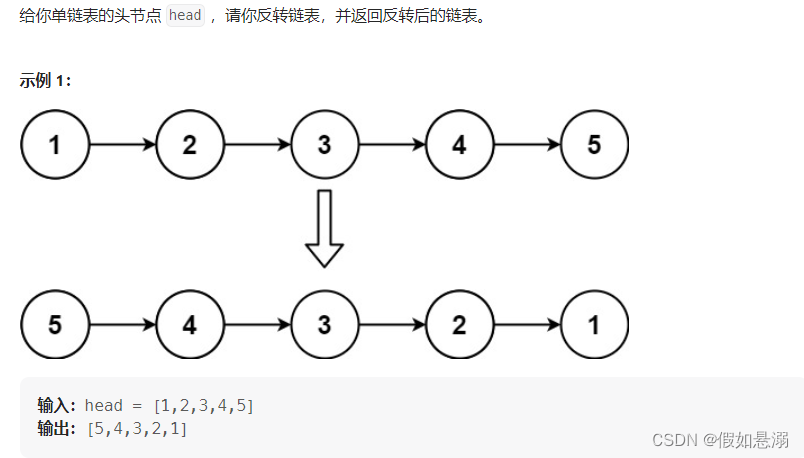
(1)原地逆转
struct ListNode* reverseList(struct ListNode* head){struct ListNode* ret=NULL,*cur=head,*pre=NULL;while(cur){ret=cur->next;cur->next=pre;pre=cur;cur=ret;}return pre;
}(2)建立一个新链表,将节点依次头插(带头结点链表)
struct ListNode* reverseList(struct ListNode* head){struct ListNode* newhead=(struct ListNode*)malloc(sizeof(struct ListNode));struct ListNode*cur=head,*ret;newhead->next=NULL;while(cur){ ret=cur->next;cur->next=newhead->next;newhead->next=cur;cur=ret;}return newhead->next;
}(3)递归
struct ListNode* reverseList(struct ListNode* head){if(head==NULL||head->next==NULL){return head;}else{struct ListNode* newhead=reverseList(head->next);head->next->next=head;head->next=NULL;return newhead;}
}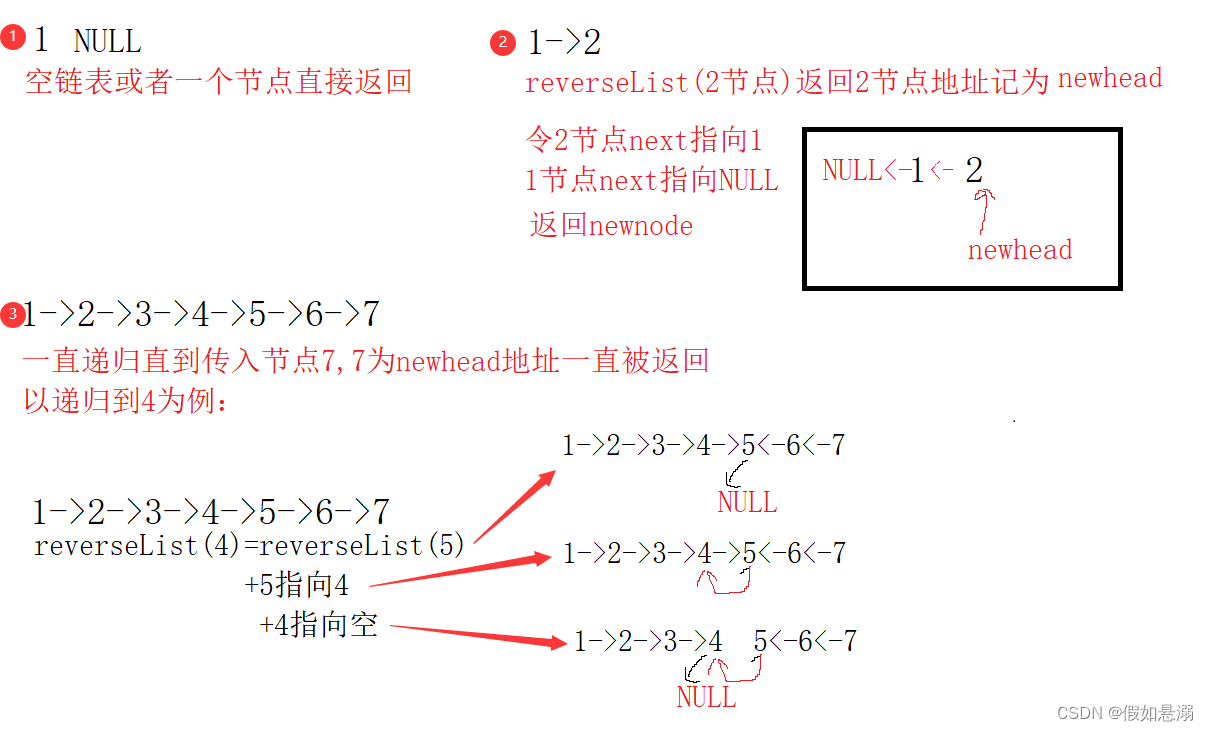
第二类:快慢指针
3. 给定一个带有头结点 head 的非空单链表,返回链表的中间结点。如果有两个中间结点,则 返回第二个中间结点。
(1)快慢指针
struct ListNode* middleNode(struct ListNode* head){struct ListNode* slow = head;struct ListNode* fast = head;while (fast != NULL && fast->next != NULL) {slow = slow->next;fast = fast->next->next;}return slow;}(2).求出size再遍历
struct ListNode* middleNode(struct ListNode* head){struct ListNode* cur = head;int size=0;while (cur) {size++;cur=cur->next;}cur = head;size/=2;while(size--){cur=cur->next;}return cur;
}(3)先遍历一遍将数据存入数组再处理
struct ListNode* middleNode(struct ListNode* head){struct ListNode* cur = head;struct ListNode* a[180];int i=0;while (cur) {a[i++]=cur;cur=cur->next;}return a[i/2];
}
4. 输入一个链表,输出该链表中倒数第k个结点。
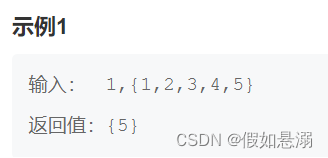
(1)快慢指针
struct ListNode* FindKthToTail(struct ListNode* pListHead, int k ) {if(pListHead==NULL||k==0)return NULL;struct ListNode* fast,*slow;fast=slow=pListHead;while(k&&fast){fast=fast->next;k--;}if(k){return NULL;}while(fast){fast=fast->next;slow=slow->next;}return slow;
}
(2).求出size再遍历size-k次
struct ListNode* FindKthToTail(struct ListNode* pListHead, int k ) {struct ListNode* cur = pListHead;int size=0;while (cur) {size++;cur=cur->next;}cur = pListHead;if(k>size)return NULL;size-=k;while(size--){cur=cur->next;}return cur;
}5. 将两个有序链表合并为一个新的有序链表并返回。新链表是通过拼接给定的两个链表的所有 结点组成的。
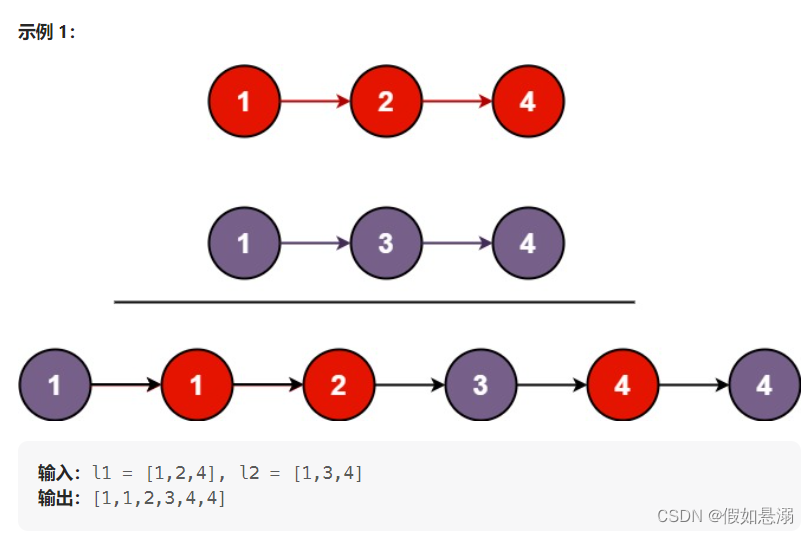 (1)直接迭代改变链接关系(使用带头链表)
(1)直接迭代改变链接关系(使用带头链表)
struct ListNode* mergeTwoLists(struct ListNode* list1, struct ListNode* list2){struct ListNode* newhead=(struct ListNode*)malloc(sizeof(struct ListNode));struct ListNode* tail;if(newhead!=NULL){tail=newhead;}struct ListNode* p1=list1,*p2=list2;tail->next=NULL;while(p1&&p2){if(p1->valval){tail->next=p1;tail=tail->next;p1=p1->next;}else{tail->next=p2;tail=tail->next;p2=p2->next;}}if(p1){tail->next=p1;}if(p2){tail->next=p2;}return newhead->next;
} (2)递归
struct ListNode* mergeTwoLists(struct ListNode* list1, struct ListNode* list2){if(list1==NULL){return list2;}if(list2==NULL){return list1;}if(list1->valval){list1->next=mergeTwoLists(list1->next,list2);return list1;}else{list2->next=mergeTwoLists(list2->next,list1);return list2;}return NULL;} 6. 编写代码,以给定值x为基准将链表分割成两部分,所有小于x的结点排在大于或等于x的结 点之前 。

创建两个链表,分别链接小于x的节点和大于x的节点:
ListNode* partition(ListNode* pHead, int x) {ListNode* newhead1=(ListNode*)malloc(sizeof(ListNode));ListNode* newhead2=(ListNode*)malloc(sizeof(ListNode));newhead1->next=NULL;newhead2->next=NULL;ListNode* tail1=newhead1;ListNode* tail2=newhead2;ListNode* cur=pHead;while(cur){if(cur->val < x){tail1->next=cur;tail1=tail1->next;}else{tail2->next=cur;tail2=tail2->next;}cur=cur->next; }tail1->next=newhead2->next;tail2->next=NULL;return newhead1->next;}7. 链表的回文结构。
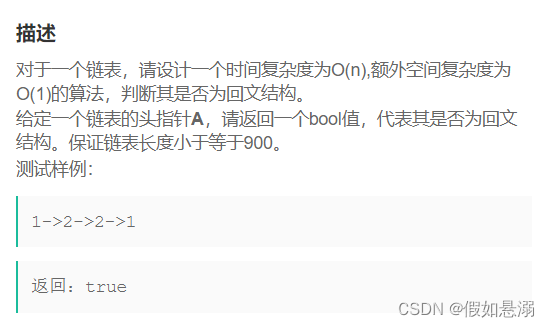
快慢指针加逆序链表
struct ListNode* reverseList(struct ListNode* head){struct ListNode* ret=NULL,*cur=head,*pre=NULL;while(cur){ret=cur->next;cur->next=pre;pre=cur;cur=ret;}return pre;}bool chkPalindrome(ListNode* A) {ListNode* slow=A,*fast=A;while(fast&&fast->next){fast=fast->next->next;slow=slow->next;}slow=reverseList(slow);while(slow&&A!=slow){if(slow->val!=A->val){return false;}slow=slow->next;A=A->next;}return true;}
8. 输入两个链表,找出它们的第一个公共结点。
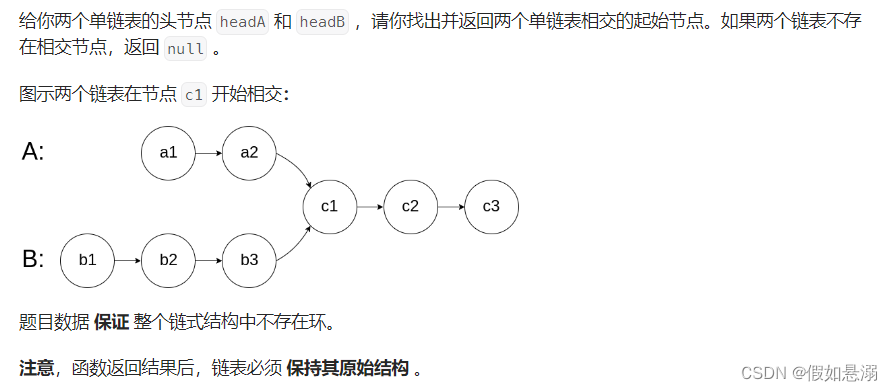
(1)先遍历两个链表,得出长度差,使得长链表先走长度差的步数,然后一起比较。
struct ListNode *getIntersectionNode(struct ListNode *headA, struct ListNode *headB) {int difsize=0;struct ListNode *p1=headA,*p2=headB;struct ListNode*longL=headA,*shortL=headB;while(p1||p2){if(p1){difsize++;p1=p1->next;}if(p2){difsize--;p2=p2->next;} }if(difsize<0){longL=headB,shortL=headA;}difsize=abs(difsize);while(difsize--){longL=longL->next;}while(longL){if(longL==shortL)return longL;else{longL=longL->next;shortL=shortL->next;}}return NULL;
}(2)不记录长度一直遍历达到两个指针指向长度一样的目的。
创建两个指针 初始时分别指向两个链表的头节点 ,然后将两个指针依次遍历两个链表的每个节点。
如果指针 pA不为空,则将指针 pA 移到下一个节点;pB同理。
如果指针 pA为空,则将指针 pA 移到链表 headB的头节点;pB同理。
当指针 pA,pB 指向同一个节点退出。
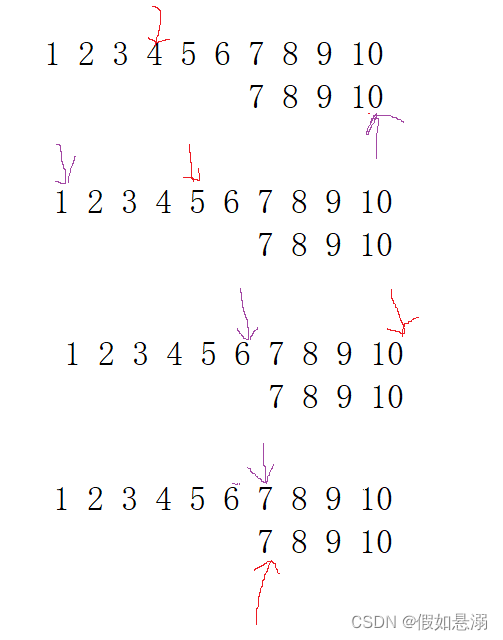
if(headA==NULL||headB==NULL){return NULL;}struct ListNode * pA = headA, *pB = headB;while (pA != pB) {if(!pA)pA =headB;if(!pB)pB =headA;if(pA == pB)break;pA=pA->next,pB=pB->next;}return pA;
}
(3)哈希表查找
struct HashTable {struct ListNode *key;UT_hash_handle hh;
};struct ListNode *getIntersectionNode(struct ListNode *headA, struct ListNode *headB) {struct HashTable *hashTable = NULL;struct ListNode *temp = headA;while (temp != NULL) {struct HashTable *tmp;HASH_FIND(hh, hashTable, &temp, sizeof(struct HashTable *), tmp);if (tmp == NULL) {tmp = malloc(sizeof(struct HashTable));tmp->key = temp;HASH_ADD(hh, hashTable, key, sizeof(struct HashTable *), tmp);}temp = temp->next;}temp = headB;while (temp != NULL) {struct HashTable *tmp;HASH_FIND(hh, hashTable, &temp, sizeof(struct HashTable *), tmp);if (tmp != NULL) {return temp;}temp = temp->next;}return NULL;
}
9. 给定一个链表,判断链表中是否有环。
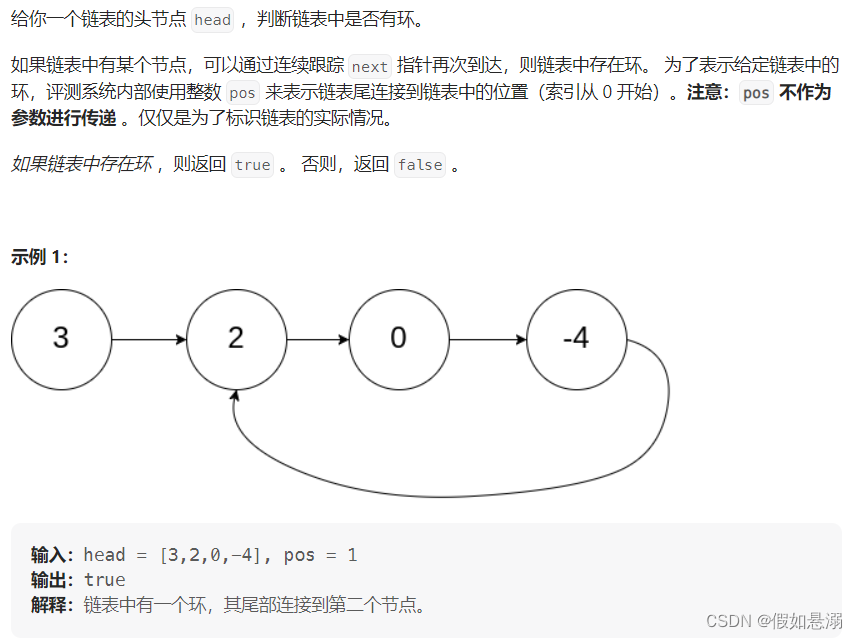
(1)快慢指针
bool hasCycle(struct ListNode *head) {if(head==NULL)return false;struct ListNode *fast=head,*slow=head;while(fast&&fast->next){fast=fast->next->next;slow=slow->next;if(fast==slow)return true;}return false;}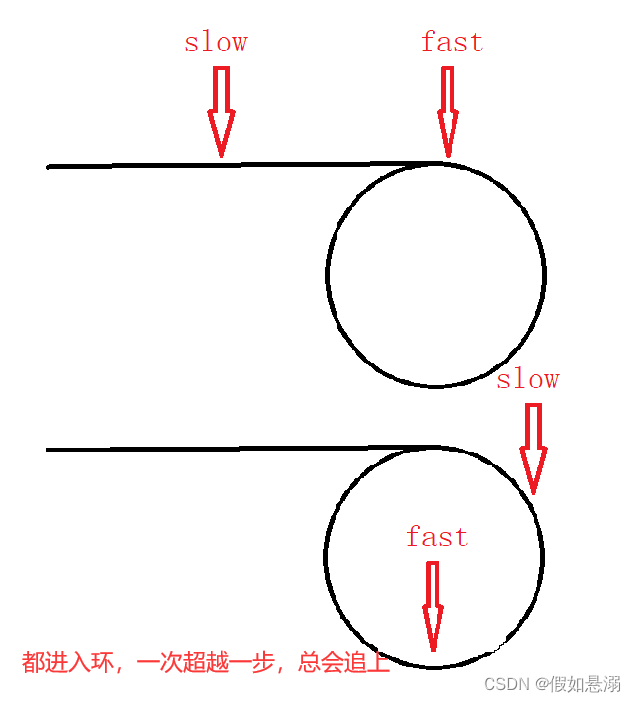
(2)哈希表
struct hashTable {struct ListNode* key;UT_hash_handle hh;
};struct hashTable* hashtable;struct hashTable* find(struct ListNode* ikey) {struct hashTable* tmp;HASH_FIND_PTR(hashtable, &ikey, tmp);return tmp;
}void insert(struct ListNode* ikey) {struct hashTable* tmp = malloc(sizeof(struct hashTable));tmp->key = ikey;HASH_ADD_PTR(hashtable, key, tmp);
}bool hasCycle(struct ListNode* head) {hashtable = NULL;while (head != NULL) {if (find(head) != NULL) {return true;}insert(head);head = head->next;}return false;
}10. 给定一个链表,返回链表开始入环的第一个结点。 如果链表无环,则返回 NULL

利用前一题的快慢指针。一指针从相遇点开始走,一指针从头开始,两者一定会在入环点相遇。
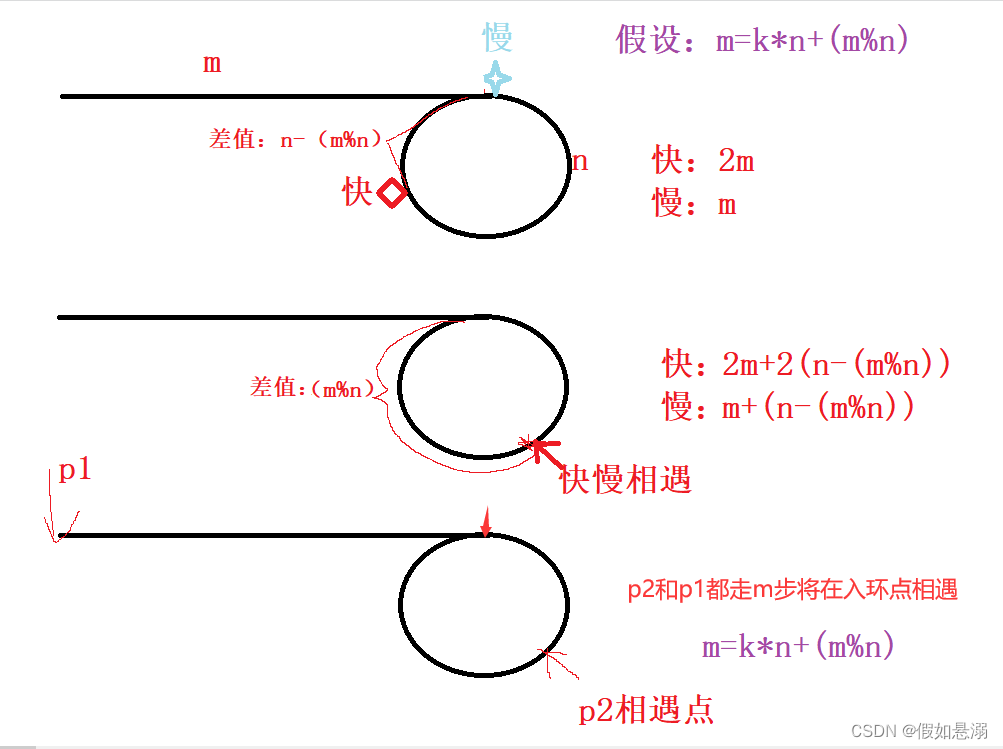
struct ListNode *detectCycle(struct ListNode *head) {if(head==NULL)return NULL;struct ListNode *fast=head,*slow=head;while(fast&&fast->next){fast=fast->next->next;slow=slow->next;if(fast==slow){slow=head;while(slow!=fast){fast=fast->next,slow=slow->next;}return fast;}}return NULL;
}11. 给定一个链表,每个结点包含一个额外增加的随机指针,该指针可以指向链表中的任何结点 或空结点。 要求返回这个链表的深度拷贝。
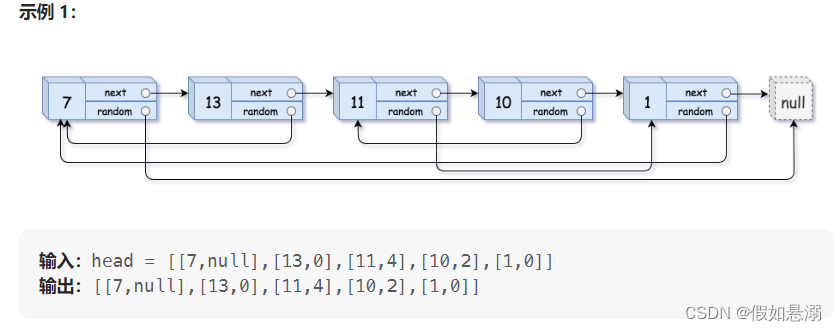
方法一:遍历两遍,第一遍创建新节点将next链接好,同时记录源节点与新节点对应关系,第二遍完成random的链接。
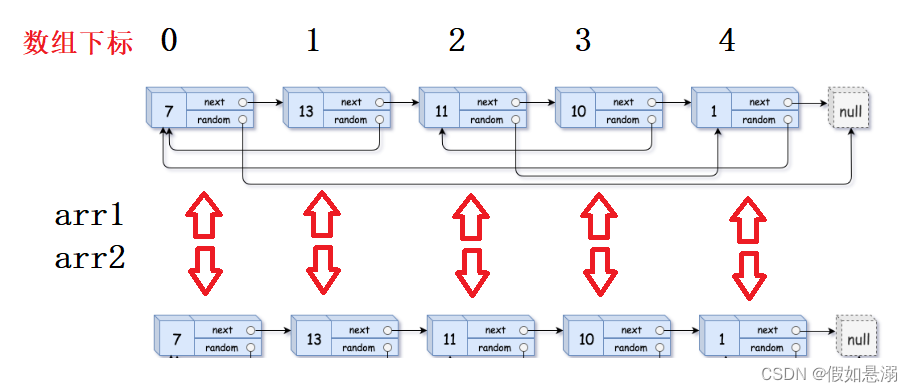
struct Node* copyRandomList(struct Node* head)
{if(head==NULL)return NULL;struct Node* arr1[1001];struct Node* arr2[1001];struct Node*cur=head;struct Node* newguard=(struct Node*)malloc(sizeof(struct Node));struct Node*ptail=newguard;assert(newguard);int index=0;while(cur){struct Node* ret=(struct Node*)malloc(sizeof(struct Node));ret->val=cur->val;ptail->next=ret;ptail=ret;arr1[index]=cur;arr2[index]=ret;cur=cur->next;index++;}cur=head;struct Node*newcur=newguard->next;while(cur){struct Node* obj=cur->random;if(obj!=NULL){for(int i=0;irandom=arr2[i];break;}}}else{newcur->random=NULL;}cur=cur->next,newcur=newcur->next;}ptail->next=NULL;return newguard->next;
} 方法二:新节点先链接进入原链表然后将新节点的random链接好,此时原来节点random指向的源节点后面就可以直接找到新节点应该指向的位置。
分为三步:
//创建新节点
//改变random指向
//将新节点剥离

struct Node* copyRandomList(struct Node* head)
{if(head==NULL)return NULL;struct Node*cur=head;//创建新节点while(cur){struct Node* ret=(struct Node*)malloc(sizeof(struct Node));ret->val=cur->val;ret->next=cur->next;cur->next=ret;cur=ret->next;}cur=head; //改变random指向while(cur){struct Node* obj=cur->next;if(cur->random==NULL){obj->random=NULL;}else{obj->random=cur->random->next;}cur=obj->next;}cur=head->next;//将新节点剥离while(cur->next){cur->next=cur->next->next;cur=cur->next;}return head->next;
}(3)
(4)
上一篇:sqli通关笔记
下一篇:列的类型定义——整形类型